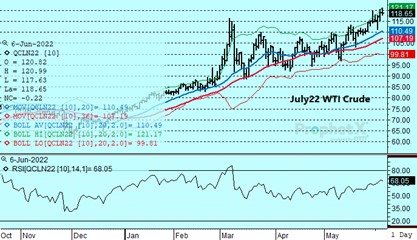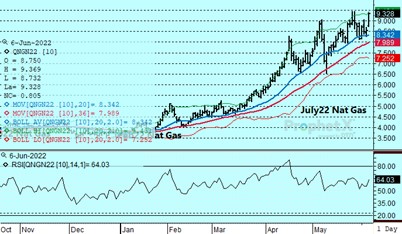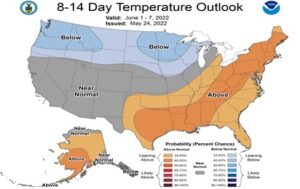by Stephen Platt and Mike McElroy
Price Overview
The petroleum complex attracted overhead selling in crude and gasoline. In WTI crude resistance above the 120 area basis July continued to be apparent reflecting ongoing fears over economic growth prospects despite the loosening of COVID restrictions in China and the appearance that high prices for gasoline might be affecting demand. Nevertheless, ULSD showed a strong tone with the July 2 Oil Crack reaching new record highs at $65.4 per barrel as tightness in Asia and Europe persists.
The appearance that OPEC might be softening their tone toward increasing production despite doubts the target level of a 648 tb/d increase in July will be achieved attracted scattered profit taking. Nevertheless support and caution on the downside continued to be apparent as Saudi Arabia hiked their Official Selling Prices for July to higher than expected levels to a differential of $ 6.5 per barrel for Asian buyers an increase of $2.1. Reports that France is in talks with the UAE to replace Russian purchases might have been taken in a negative way on the appearance key mid-East producers might be more willing than they have been in the past to replace Russian barrels given the availability of some sustainable excess capacity in both the UAE and Saudi Arabia and also to a lesser extent Iraq.
Following last week’s bullish surprise in the DOE report, the market will be awaiting this weeks numbers with great anticipation. Currently, the report is expected to show crude stocks off 1.8 while gasoline is expected up. .6 and up .3 mb in distillate. Refinery utilization is expected to increase by .4 to 93 percent.
The strong margins continue to prevail along with active export demand. Nevertheless indications that demand will be throttled back by the higher prices might become a key consideration. Typically the demand response can be slow to develop but with consumers continuing to try to find ways to cut costs as incomes are strained by inflationary pressure a retrenchment in disappearance levels is a possibility.



Natural Gas
Prices traded sharply higher rising as much as 75 cents basis July following forecasts for hotter weather and higher demand than previously expected, a decline in output, high export levels and on concern over record power demand in Texas. Lagging production of Nat gas in the US remains a key consideration as output lags levels prevailing in May at 94.7 mbtu/d. With export levels of LNG remaining near capacity and prospects for wind production falling this next week, inventory levels remain a source of concern. Currently, US inventories are 15 percent below their five year norm for this time of year. It is interesting to note that these levels are below those in Europe which are 9 percent below the five year average and where prices are substantially higher. With the temperature outlook pointing to above normal temps for the Eastern US and most of Texas demand and inventory levels will play an increasing role in price movement. The weather concerns along with stagnant production and solid LNG flows continue to keep a bid under this market that could carry values up to the 10.00 area basis July just as Hurricane season gets under way.
Futures and options trading involve significant risk of loss and may not be suitable for everyone. Therefore, carefully consider whether such trading is suitable for you in light of your financial condition. The information and comments contained herein is provided by ADMIS and in no way should be construed to be information provided by ADM. The author of this report did not have a financial interest in any of the contracts discussed in this report at the time the report was prepared. The information provided is designed to assist in your analysis and evaluation of the futures and options markets. However, any decisions you may make to buy, sell or hold a futures or options position on such research are entirely your own and not in any way deemed to be endorsed by or attributed to ADMIS. Copyright ADM Investor Services, Inc.
